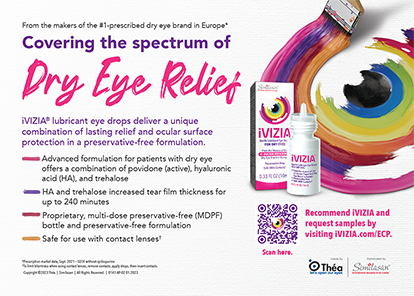

Assessing the Likely Effect of Posterior Corneal Curvature on Toric IOL Calculation for IOLs of 2.50 D or Greater Cylinder Power
LaHood BR, Goggin M, Esterman A1
ABSTRACT SUMMARY
LaHood and colleagues performed a retrospective study to establish whether the posterior corneal surface influences the over- or undercorrection of astigmatic eyes. The researchers reviewed the records of 101 patients (113 eyes) requiring the implantation of a toric IOL (AT TORBI 709M or 709MP Toric, Carl Zeiss Meditec; not available in the United States) with a cylinder power of 2.50 D or higher. The investigators grouped eyes as follows: (1) with-the-rule (WTR) if the steep axis of the anterior cornea was between 60º and 120º and (2) against-the-rule (ATR) if the steep axis of the anterior cornea was between 0º and 30º and 150º and 180º. The main outcome measure was the postoperative refractive astigmatic prediction error.
A mean overcorrection of 0.16 ±0.57 D and a mean undercorrection of -0.14 ±0.53 D occurred in the WTR and ATR subgroups, respectively. Although these values were statistically significant (WTR: P = .04, ATR: P = .05), the effect sizes of these prediction errors were 0.40 for WTR and 0.36 for ATR, and the error values fell below a clinically significant value of 0.25 D.
The investigators concluded that eyes requiring toric IOLs with a cylinder power of 2.50 D or higher showed an overcorrection if they had anterior WTR astigmatism and an undercorrection if they had anterior ATR astigmatism. Because these correction values fell below the clinically significant value of 0.25 D, IOL cylinder powers were accurately calculated using unadjusted anterior keratometry values.
STUDY IN BRIEF
Investigators confirmed that, when considering posterior corneal curvature in IOL power calculations, there is a statistically but not a clinically significant overcorrection of eyes that have with-the-rule astigmatism and a statistically but not a clinically significant undercorrection of eyes with against-the-rule astigmatism that need a toric lens power of 2.50 D or higher.
WHY IT MATTERS
Patient expectations of achieving the targeted correction with toric IOLs has risen greatly. Although research has demonstrated that calculations for toric IOLs with a cylinder power of 2.00 D or less may require a correction factor that accounts for the posterior corneal surface, this study shows a correction factor is unnecessary for IOLs with cylinder powers of 2.50 D or higher.
DISCUSSION
The posterior cornea’s shape has long been known to affect total corneal astigmatism,2,3 so the calculations for toric IOLs have evolved to incorporate posterior corneal astigmatism.4-6 The methodology currently available for measuring or estimating the posterior corneal surface has its limitations, however, and further improvement in this area is warranted.7
Even with the limitations of instrumentation, LaHood and colleagues found that the posterior cornea’s effect on IOL calculations was not clinically significant in eyes requiring a toric IOL cylinder power of 2.50 D or more. They confirmed a statistically significant effect of the posterior corneal surface, but it only translated to a magnitude of error CI of -0.27 to 0.00 D in eyes with ATR astigmatism and 0.01 to 0.32 D in eyes with WTR astigmatism. Their findings contrast with the previously reported clinically and statistically significant overcorrection of eyes with WTR astigmatism and undercorrection of eyes with ATR astigmatism that needed a toric IOL with a cylinder power of 2.00 D or less.8 It was also noted that, when applying a coefficient of adjustment in eyes requiring a toric IOL cylinder power of 2.00 D or less (0.75 D for WTR and 1.41 D for ATR), there was an improvement in astigmatic outcomes.6 Although not implied by the results of the review by LaHood et al, further study is warranted to determine if a correction coefficient could improve the astigmatic outcomes in eyes requiring toric IOLs that have a cylinder power of 2.50 D or higher.
Overall, this study is notable for minimizing confounding variables when possible. Elaborating on their astigmatically neutral incision, the investigators demonstrated their findings using the mean preoperative astigmatism to be corrected by evaluating the mean postoperative astigmatism as the net value to be corrected, thus avoiding the effect of any inadvertent corneal astigmatic change. The 95% CI of the difference between these averages (-0.013 to 0.082 D) fell within a range of ±0.25 D and can consequently be considered insignificant.
Comparison of Methodologies Using Estimated or Measured Values of Total Corneal Astigmatism for Toric Intraocular Lens Power Calculation
Ferreira TB, Ribeiro P, Ribeiro FJ, O’Neill JG9
ABSTRACT SUMMARY
Ferreira and colleagues performed a retrospective study to compare calculation methods that estimate the power of the posterior corneal surface (Barrett Toric Calculator and Abulafia-Koch formula) with methods that obtain real measurements of the posterior corneal surface using Scheimpflug imaging (Panacea IOL and Toric Calculator [www.panaceaiolandtoriccalculator.com] and PhacoOptics ray-tracing software [PhacoOptics]). The review included 107 eyes of 107 patients requiring toric IOL implantation (AcrySof IQ Toric SN6AT3–T9, Alcon). The investigators compared predicted residual astigmatism with manifest refraction astigmatism values. A subgroup analysis then compared these formulas in eyes that had WTR or ATR astigmatism. The researchers subgrouped eyes as follows: (1) WTR if the steep axis of the anterior cornea fell between 60º and 120º and (2) ATR if the steep axis of the anterior cornea fell between 0º and 30º and 150º and 180º.
Both posterior corneal surface estimation methods (Barrett Toric Calculator and the combination of the Abulafia-Koch formula with the Holladay calculator) had lower mean and centroid astigmatic prediction errors than the methods considering real measures (P < .001). The total number of eyes within ±0.50 D of the absolute prediction error was also higher in the estimation group than in the real measurement formulas group. There was no significant difference in mean absolute error and centroid prediction error (CPE) for the different toric IOL types (SN6AT3–T9). The CPE was 0.07 D X 172º for the Barrett Toric Calculator and 0.13 D X 174º for the Abulafia-Koch formula. For the real measurement formulas, the CPE was 0.25 D X 173º for the Panacea calculator and 0.29 D X 171º for the PhacoOptics ray-tracing software. The subgroup analysis showed that all calculation methods overcorrected eyes with WTR astigmatism and undercorrected eyes with ATR astigmatism.
The investigators concluded that the Barrett Toric Calculator and the Abulafia-Koch formula yielded the lowest astigmatic prediction errors and that the direct evaluation of total corneal power is not superior to its estimation.
STUDY IN BRIEF
A study comparing IOL formulas showed that the Barrett Toric Calculator and the Abulafia-Koch formula, both methods that estimate the power of the posterior corneal surface, yielded less astigmatic prediction error than methods that consider real posterior corneal measurements obtained with Scheimpflug imaging.
WHY IT MATTERS
The limitations of current imaging modalities to accurately measure the posterior corneal surface raise concern among ophthalmologists with regard to selecting toric IOLs. In this study, the IOL formulas that estimate the posterior corneal surface showed better predictability than formulas that try to use real measurements of the posterior corneal surface. This result should ease the process of selecting a toric IOL.
DISCUSSION
Koch and colleagues reported that the average posterior corneal astigmatism is 0.30 D, with a steeper axis along the vertical meridian, and they noted that ignoring this value can produce off-target astigmatic results.10 With the limitations of the currently available posterior corneal imaging modalities, the review by Ferreira and colleagues provides an applicable comparison of the toric IOL calculation formulas that estimate versus measure the posterior corneal power.
Both the Barrett Toric Calculator and the combination of the Abulafia-Koch formula with the Holladay calculator yielded better postoperative astigmatic outcomes than their real measure counterparts. Although the review elaborates on the total number of eyes within ±0.50 D of the absolute prediction error, it should be noted that the percentage of eyes within ±0.25 D of absolute prediction error was 38.5% for the estimation formulas versus 10% for the real measure formulas at 3 months. When comparing the estimation formulas, the Barrett Toric Calculator had insignificantly better results than the Abulafia-Koch formula combined with the Holladay formula. Previously, however, the Barrett Toric Calculator was shown to produce significantly better results than the Holladay toric calculator whether or not corrective nomograms were used.11 Further studies comparing the real measurement–based formulas are warranted.
With similar confounding variable control as the retrospective review by LaHood and colleagues in terms of surgical technique and patient marking,1 Ferreira and colleagues were also able to control refraction variability by using only one refractionist. This research is an important addition because interexaminer variability has been noted as 80% within ±0.25 D and 95% within ±0.50 D, which had the potential to skew these results.12
The findings of Ferreira and colleagues9 (combined with those of LaHood et al1) should reassure ophthalmologists seeking predictable refractive outcomes.
1. LaHood B, Goggin M, Esterman A. Assessing the likely effect of posterior corneal curvature on toric IOL calculation for IOLs of 2.50 D or greater cylinder power. J Refract Surg. 2017;33(11):730-734.
2. Royston JM, Dunne MC, Barnes DA. Measurement of posterior corneal surface toricity. Optom Vis Sci. 1990;67(10):757-763.
3. Dunne MC, Royston JM, Barnes DA. Posterior corneal surface toricity and total corneal astigmatism. Optom Vis Sci. 1991;68(9):708-710.
4. Koch DD, Ali SF, Weikert MP, et al. Contribution of posterior corneal astigmatism to total corneal astigmatism. J Cataract Refract Surg. 2012;38(12):2080-2087.
5. Koch DD, Jenkins RB, Weikert MP, et al. Correcting astigmatism with toric intraocular lenses: effect of posterior corneal astigmatism. J Cataract Refract Surg. 2013;39(12):1803-1809.
6. Goggin M, van Zyl L, Caputo S, Esterman A. Outcome of adjustment for posterior corneal curvature in toric intraocular lens calculation and selection. J Cataract Refract Surg. 2016;42(10):1441-1448.
7. Holladay JT, Dudeja DR, Koch DD. Evaluating and reporting astigmatism for individual and aggregate data. J Cataract Refract Surg. 1998;24(1):57-65.
8. Goggin M, Zamora-Alejo K, Esterman A, van Zyl L. Adjustment of anterior corneal astigmatism values to incorporate the likely effect of posterior corneal curvature for toric intraocular lens calculation. J Refract Surg. 2015;31(2):98-102.
9. Ferreira TB, Ribeiro P, Ribeiro FJ, O’Neill JG. Comparison of methodologies using estimated or measured values of total corneal astigmatism for toric intraocular lens power calculation. J Refract Surg. 2017;33(12):794-800.
10. Koch DD, Ali SF, Weikert MP, et al. Contribution of posterior corneal astigmatism to total corneal astigmatism. J Cataract Refract Surg. 2012;38(12):2080-2087.
11. Abulafia A, Barrett GD, Kleinmann G, et al. Prediction of refractive outcomes with toric intraocular lens implantation. J Cataract Refract Surg. 2015;41(5):936-944.
12. Goss DA, Grosvenor T. Reliability of refraction—a literature review. J Am Optom Assoc. 1996;67(10):619-630.




